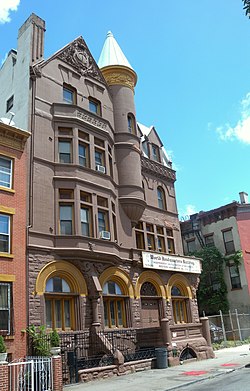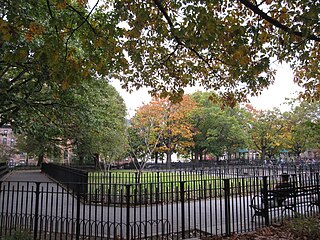
Clinton Hill is a neighborhood in north-central Brooklyn, a borough of New York City. It is bordered by the Brooklyn Navy Yard and Flushing Avenue to the north, Williamsburg to the northeast, Nostrand Avenue and Bedford–Stuyvesant to the east, St Marks Avenue and Prospect Heights to the south and southwest and Carlton Avenue and Fort Greene to the west.
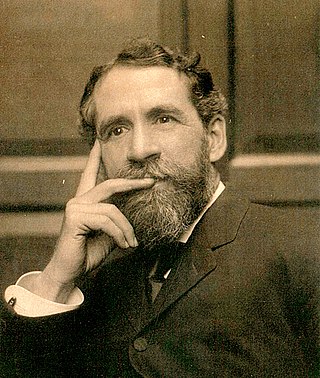
William Bunker Tubby was an American architect who was particularly notable for his work in New York City.

Andrews United Methodist Church is a historic Methodist church at 95 Richmond Street in Cypress Hills, Brooklyn, New York, United States. It is now Andrews Ghana Wesley United Methodist Church. It was built in 1893 and is a one-story, asymmetrical orange brick church in the Queen Anne style. It features a massive rose window on the front facade and a three-story, square bell tower. The interior is arranged on the Akron Plan. Attached to the church is a two-story Sunday school wing. Also on the property is the original church parsonage It is a two-story frame dwelling built in 1878–1879 in the Italianate style.

Baptist Temple is a historic Baptist church at 360 Schermerhorn Street in Brooklyn, New York. It was built in 1893–1894 in the Romanesque Revival style and rebuilt after a fire in 1917–1918. It has a brownstone base and superstructure faced with subtly textured brick with brownstone trim. The building features a large rose window and three corner towers.

The Friends Meetinghouse and School is a Quaker meeting house and adjacent school building at the corner of Schermerhorn Street and Boerum Place in the Boerum Hill neighborhood of Brooklyn, New York City.

St. Mary's Episcopal Church is an historic Episcopal church at 230 Classon Avenue in Clinton Hill, Brooklyn, New York City. It was built in 1858 of Belleville brownstone in the Gothic Revival style.

The Astral Apartments is an apartment building located at 184 Franklin Street in Greenpoint, Brooklyn, New York City. The Astral was built in 1885–1886 as affordable housing for employees of Charles Pratt's Astral Oil Works. It is a block-long brick and terra cotta building in the Queen Anne style. It features a central projecting section with a deep, three-story-high round arch recess. The roof features inward-looking decorative grotesques. Original amenities of the building included a settlement house, library, and kindergarten.

Public Bath No. 7 is a historic bathhouse located in Park Slope, Brooklyn, New York City. It was designed by Brooklyn architect Raymond F. Almirall. It was built between 1906 and 1910 and is constructed of white glazed brick and limestone colored terra cotta blocks. The design is based on a Renaissance palazzo. It measures three bays by five bays. The bathhouse was converted to a gymnasium in 1937.

Coney Island Fire Station Pumping Station is a historic pumping station located in Brooklyn, New York, New York. It was built in 1938 in the Moderne style. It is a one-story, elliptical-shaped building faced in limestone. It sits on a granite base and has projecting porticos and metal doorways.
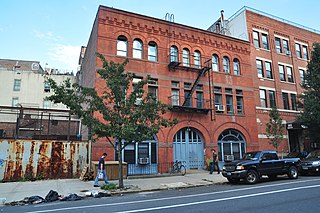
Feuchtwanger Stable is a historic stable building located in Fort Greene, Brooklyn, New York. It was built in 1888 in the Romanesque Revival style. It is a three-story brick structure trimmed with stone and terra cotta. The first floor features three wide, round arches that once served as entrances for horses. The building has housed a candy factory, a storage warehouse, and an auto repair garage. It was converted into loft condominiums in 1988.

Knickerbocker Field Club is a historic tennis association located in Flatbush, Brooklyn, New York, New York. It was founded in 1889, and continues to operate to this day.
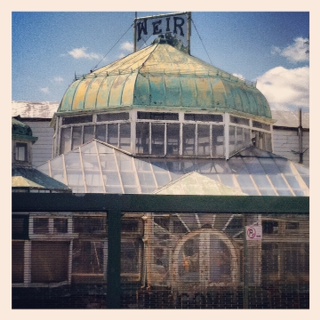
Weir Greenhouse is a historic greenhouse located across the street from the main entrance of Green-Wood Cemetery in Sunset Park, Brooklyn, New York City. It was designed by George Curtis Gillespie and built in 1895 by James Weir, Jr., a Brooklyn florist who had been in business for 50 years when he built the greenhouse for the business he operated with his son and grandson. It is a rectangular, wood frame and galvanized iron building with projecting bays and domes in the Victorian commercial style. The main entrance is set at an angle to the street corner and is octagonal in form. The rooftop features an octagonal cupola with a ball finial. Attached to the greenhouse is a one-story brick office structure.

The Carroll Gardens Historic District is a small municipal and national historic district located in the Carroll Gardens neighborhood of Brooklyn, New York City. The national district consists of 134 contributing residential rowhouses built between the 1860s and 1880s. They are two- and three-story brownstone buildings in the neo-Grec and late Italianate styles located in a rectangle bounded by Carroll, President, Smith, and Hoyt Streets. They feature uniform setbacks, even cornice lines and stoop levels, and fenced front yards and landscaped gardens. These were the result of surveyor Richard Butt, who in 1846 planned gardens in front of the brownstone houses in the oldest section of the neighborhood. The homes are set farther back from the street than is common in Brooklyn, and the large gardens became an iconic depiction of the neighborhood. All the houses in the district, which is afforded a degree of privacy by the street pattern that discourages through traffic on Carroll and President Streets, were built between 1869 and 1884.
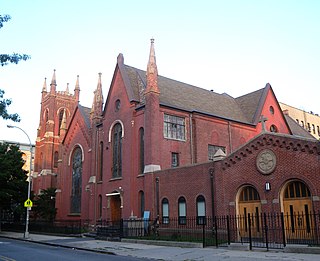
Clinton Hill Historic District is a national historic district in Clinton Hill, Brooklyn, in New York City. It consists of 1,063 largely residential contributing buildings built between the 1840s and 1930 in popular contemporary and revival styles. Buildings include freestanding mansions, row houses, and apartment buildings. The district includes the mansions of Clinton Avenue, built in the 1870s and 1880s. The most prominent of these are linked to Charles Pratt, who built a mansion for himself at 232 Clinton Avenue in 1874, the year his Charles Pratt & Company was acquired by Standard Oil, and one each as wedding presents for three of his four sons. These four mansions can be seen on Clinton Avenue between DeKalb and Willoughby. The rest of the historic district is noted for its prominent Italianate and Beaux-Arts rowhouses. The Clinton Hill South Historic District was listed in 1986.

Clinton Hill South Historic District is a national historic district in Clinton Hill, Brooklyn, in New York City. It consists of 246 largely residential contributing buildings built between the 1850s and 1922. It includes fine examples of Neo-Grec style row houses. Also in the district are a number of early 20th century apartment buildings in the Colonial Revival style.

The houses at 216–264 Ovington Ave. form a national historic district in Bay Ridge, Brooklyn, New York, New York. It consists of 20 contributing residential buildings built between 1908 and 1910. They are brownstone rowhouses with bowed fronts in the Neo-Renaissance style. The houses are two or three stories in height.

Senator Street Historic District is a national historic district in Bay Ridge, Brooklyn, New York, New York. It consists of 40 contributing residential buildings built between 1906 and 1912. They are all three story brownstone rowhouses in the Neo-Renaissance style. The houses feature high stoops and full sized subterranean basements.
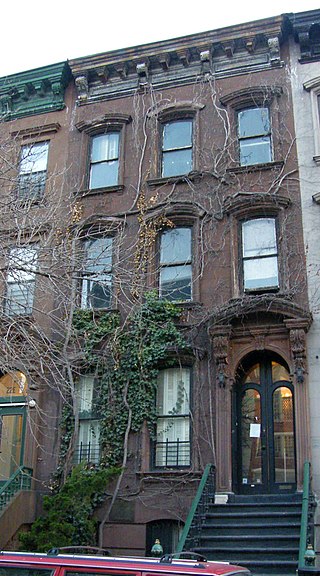
The Langston Hughes House is a historic home located in Harlem, Manhattan, New York City. It is an Italianate style dwelling built in 1869. It is a three-story-with-basement, rowhouse faced in brownstone and measuring 20 feet wide and 45 feet deep. Noted African American poet and author Langston Hughes (1902–1967) occupied the top floor as his workroom from 1947 to 1967.

Manhattan Avenue–West 120th–123rd Streets Historic District is a national historic district in the Harlem neighborhood of Manhattan in New York City. It consists of 113 contributing residential rowhouses built between 1886 and 1896. The buildings are three story brownstone and brick rowhouses over raised basements in the Queen Anne, Romanesque, and Neo-Grec styles.
This is a timeline and chronology of the history of Brooklyn, New York. Brooklyn is the most populous of New York City's boroughs, and was settled in 1646.
